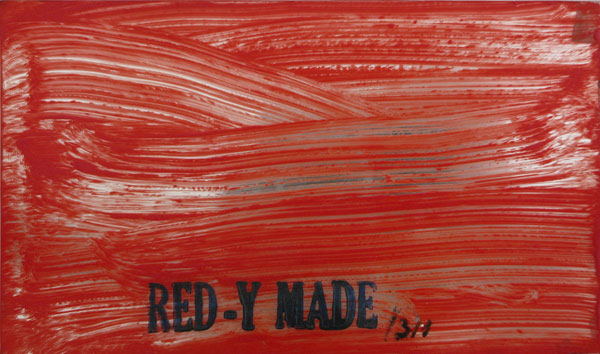
Hot Work no.4, 1970 ◼ Stone Corner, 1970
◼ Elképzelés projekt (1971) CSAVART PLASZTIKA III., /1970/
◼ Kopaszítás, 1970
◼ Negatív csillag, 1971
◼ TUDJA ÖN AZT, HOGY AZ ALÁBBIAKBÓL MILYEN MENNYISÉG VAN A FÖLDÖN?, 1971
◼ Ön találhat minden négyzethez különböző négyzeteket, 1971
◼ Specie study / fémpénz tanulmány, 1971
◼ Artists' money / művészpénz, 1971
◼ GÁBOR ATTALAI – MAP WORKS FOR KLAUS GROH (1971)
Attalai Gábor – térkép-munkák Klaus Groh-nak (1971)
◼ Training my foot for future hard steps / Edzés soronkövetkező nehéz lépések előtt, 1971
◼ I can be foolish too 1-2 / Én is hülyíthetem magam 1-2., 1973
◼ Kézzel és lábbal, 1973?
◼ Alternatives, photo / Alternatívák, fotó, 1973

Painting from back side / Festmény hátulról, 1974

Red-y made mirror / Red-y made tükör, 1973
◼ Mirror / Tükör, 1973
◼ Red-y made works / Red-y made munkák, 1974

ARTPUL KATAPULT - Postcard /képeslap, 1981 (Theodore von Kármán / Kármán Tódor)
◼ Red-y made shadows of the lines of the work plus a point. 1982

Skating on glass / Korcsolyázás az üvegen, 1976
◼ I START TO SKATE (artistamp / művészbélyeg), 1982
TENDENCIÁKRÓL ÉS TENDENCIÁINKRÓL A 70-ES ÉVEK VÉGÉRŐL NÉZVE
(tanulmány, 1980)
Határesetek a képzőművészetben (tanulmány, 1981)

A kezdet, mint végzet, 1981
◼ Attalai Gábor - grafikus, textilművész (Artportál)
(Budapest, 1934. november 20.–Budapest, 2011. július 23.)
◼ Attalai Gábor - artist in textile, industrial designer, graphic artist (Artportál)
(born Bp., 20th November 1934 - dead Bp., 23th July 2011.)
◼ Sajnos István projekt, szöveg-munka 1995
Hock Beáta: Attalai Gábor (részlet a Kállai Ernő ösztöndíj
segítségével végzett performansz-kutatási beszámolóból) 2000
Hock Beáta: Attalai Gábor (interjú) 2001
◼ Wikipedia: Attalai Gábor

◼ Attalai Gábor - 1992- a Magyar Művészeti Akadémia tagja

Attalai Gábor (Budapest, 1934), conceptual artist, photographer, designer and graphic artist, installation artist and performer, is one of the leading representatives of the Hungarian artistic nomadism. In his conceptual work, with a large dose of humor and irony, he explores the relationship between art practice and theory, as well as art and its environment. During the seventies he was, among others, interested in a specific variation of temporal land art, for example creating a shape of a star in the snow on the steps of the Danube quay in Budapest. In his later works he explores the relationship between color and object, especially the changes in meaning and symbolism of color in different historical periods. A series of objects from the late seventies are in terms of discipline a combination of monochrome and ready made. Attalai Gábor in it covers a working uniform, cap, serving utensils, tools and materials with red paint. He thus demonstrates and at the same time ironizes the ideological indoctrination of labor movement that has pervaded all aspects of the work process and the production of reality. At the same time, he indicates the dependance and changes of the meaning of color within the socio-political context, apropos its close connection with the creative process, regardless of whether it is, as in his case, product design, painting or sculpture.
His view on "the madness of functioning" of the communist system is best expressed in a series of ludic photographic portraits. According to Gábor, the standard situation in communist countries was marked by suffocation and lack of freedom and the ideological "dialogue" that the communist regime imposed on its subjects. Because of its unidirectional nature which did not include the views of the population, but has imposed its concepts as the truth, the so-called "dialogue" was doomed to failure. Attalai Gábor says that therefore anyone who did not want to go crazy in the communist countries had to act like he was crazy. [source]